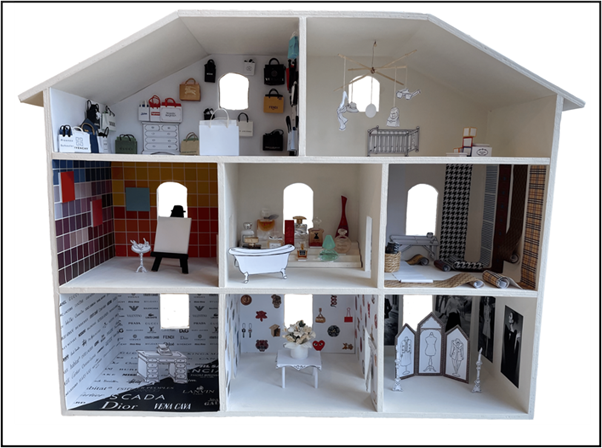'House of Heritage': The third instalment of the LCF vitrine project

- Written byCharlotte Delacour, Hester Mauduit, Claire Mosley and Claire Vagner. for the Centre for Fashion Curation
- Published date 31 January 2022

The third instalment of the LCF vitrine project at London College of Fashion’s John Prince’s Street site, was realised by MA Fashion Curation students/graduates Charlotte Delacour, Hester Mauduit, Claire Mosley and Claire Vagner. Here they write about the experience:
The vitrine project, a component of the MA for Fashion Curation course at LCF, has been a fascinating exercise in exhibition-making. The aim of the project was to create visual, physical exhibitions by breaking down the word reconstruction into four discrete visual interpretations.
Our approach to this theme was to look at contemporary fashion brands and see how they continuously renew their image through key identifiers. We examined their attributes to define the common denominators that create a brand's heritage and arranged them into eight themes. Each is represented by a room within our dollhouse, our House of Heritage. The themes included font, colours, symbols, perfumes, logos, characteristic packaging, identifiable accessories and clothing silhouettes.

The eight rooms inside the dollhouse
We conceived the idea of making a dollhouse to visually represent the attributes intrinsic to all fashion houses. We agreed that the vitrine should be represented by a single object, both light-hearted and instantly recognisable to our knowledgeable audience (within the halls of a University of design and fashion studies). Each attribute was then linked to a room, from study to nursery, which conveyed its distinct function, and concretised our idea for the dollhouse within the vitrine.
The main challenge was to decorate each room in a way that would combine and adhere to the key elements found in both dollhouse and fashion house. Each room revolved around a visual pun for the identified theme and was enhanced by illustrations of furniture.

Charlotte and Claire M. install the house in the vitrine
To create an object that cohered to the sustainability and curatorial goals of the project was challenging. We were inspired, however, by a DIY model found online and, driven by practicality, correlate with the scale of the vitrine.
The construction itself was straightforward: we selected a recyclable wood from which to cut our dollhouse. However, assembling the sections became problematic as the wood began to warp. To compensate for this and to anticipate the transportation of the fragile dollhouse, we opted to use screws instead of a sustainable but less durable wood glue. The house had to travel from Normandy to London so we wrapped it with care and transformed it into its own self-contained suitcase to make transport safer and easier.

The dollhouse, wrapped, is transported by train from Normandy to London
Great fashion is not formulaic, but provocative. Thus, we developed the dollhouse to serve dual purposes: to question traditional heritage-marketing methods and to inspire students who want to challenge the formulaic when developing their own brands. In a lecture given by LCF curator James Putnam regarding his collaboration with the artist Fred Wilson, he talked about utilising the museum itself as a medium. We were influenced by this philosophy and decided to utilise the back glass of the vitrine in our scenographic strategy by adding a red graffiti slogan over it stating, “Can you break the formula?” This called into question the front of the vitrine and the dollhouse and created something unexpected, expanding our museum canvas. It enhanced the visuals of our exhibit and created a disruptor to our initial project.

Hester and Charlotte install the graffiti vinyl
The addition of this disruptive element provided a more nuanced display which allowed for a stronger curatorial statement. With witty yet subtle metaphors of travelling from birth in the nursery, under a revolving mobile of accessories, to achieving salvation in a chapel in front of a triptych of iconic fashion symbols, our dollhouse should amuse and provoke.

Composition overview of the vitrine front and back
Our project was guided throughout with assistance and encouragement from project leader Alison Moloney and technical assistance from Fergus O’Connor. We would also like to thank Orawee Choedamphai, Bangkok, who kindly shipped and donated the paper flowers and Luke Turk for providing the vinyl. To follow further the development of the project please go to the @LCF_Vitrine Instagram.

Final display of the House of Heritage in the LCF vitrine